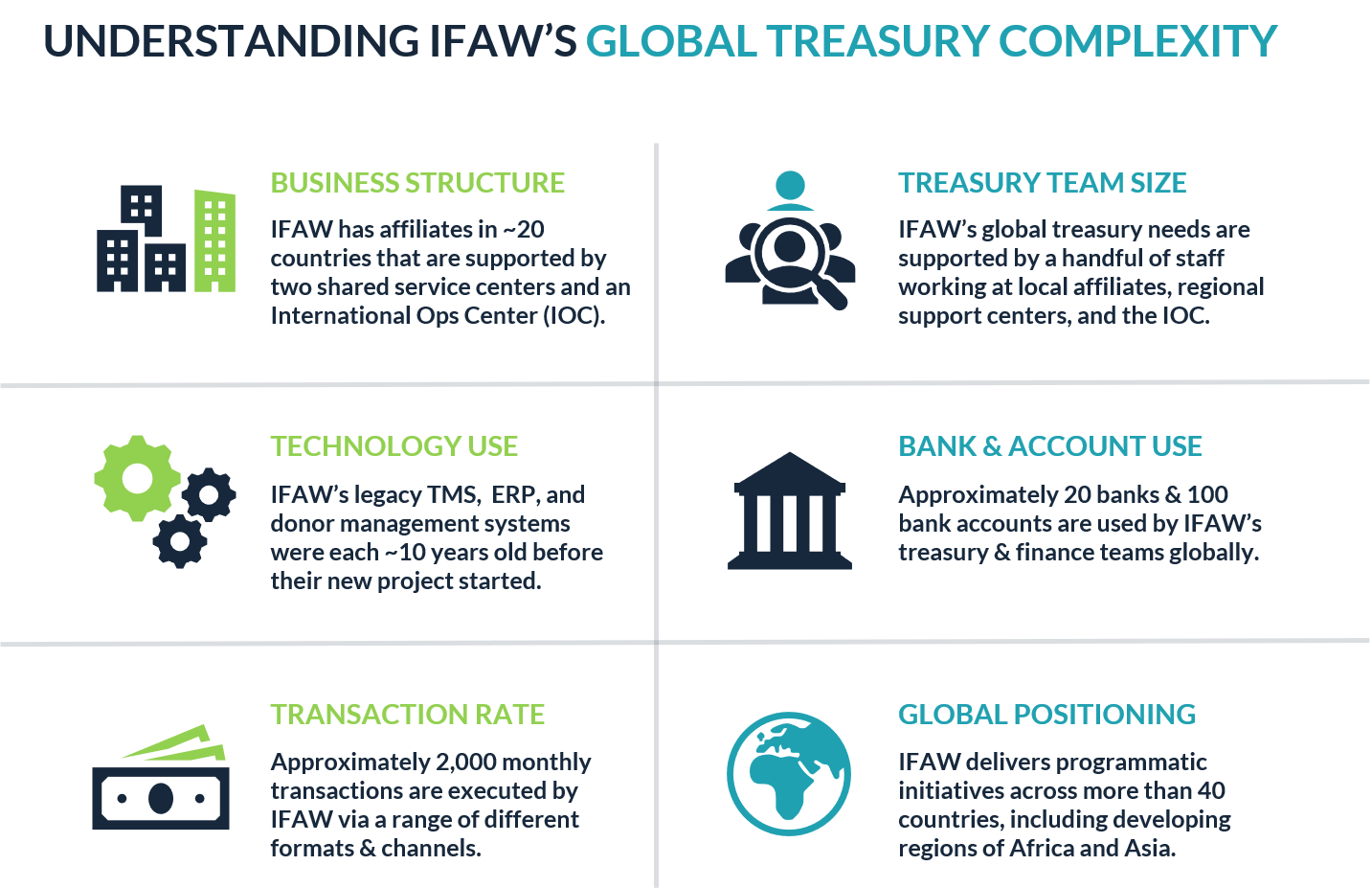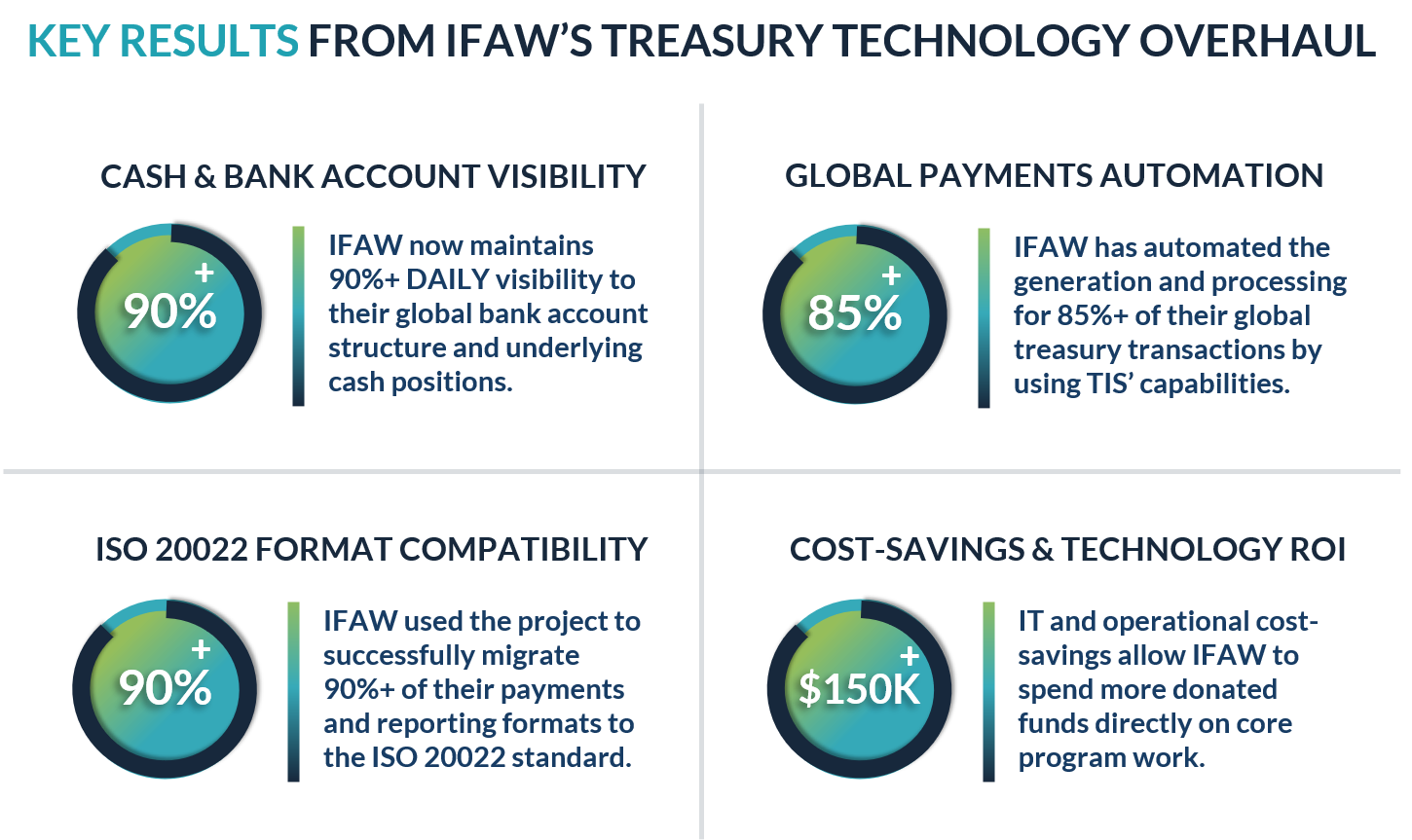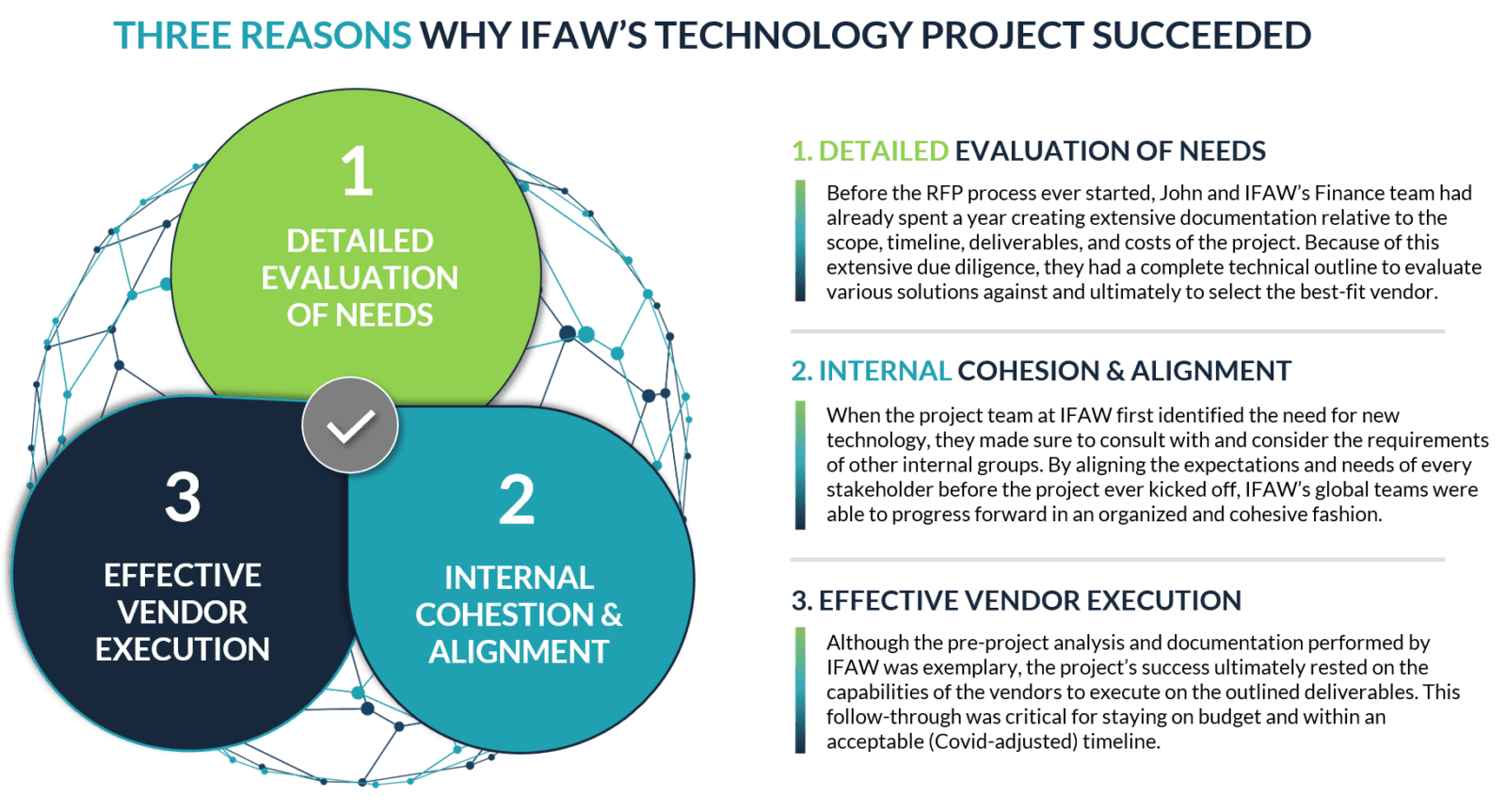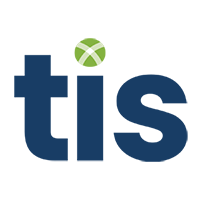Notice: The NGO highlighted in this blog (IFAW) was recently selected as a 2022 Awards Finalist by Treasury & Risk for Best Practices in Restricted & Emerging Markets. You can learn more about the awards ceremony and IFAW’s recognition here.
Setting the Stage: IFAW’s Program Work and Complexity Grows but Their Technology Remains the Same
From ~2008 to 2018, the small treasury team at the International Fund for Animal Welfare (IFAW) operated with virtually the exact same technology infrastructure, despite a substantial increase in global complexity and expansion that had occurred during that timeframe as a result of its growing programmatic initiatives.
When Group Treasurer for IFAW, John Kluza, first began evaluating a new framework for their treasury technology stack in 2018, the team had been using the same TMS for nearly a decade. In addition to a variety of spreadsheets and bank portals, 20 banks, 100 accounts, and a locally hosted ERP that was critical for IFAW’s other internal departments, the rapidly expanding non-profit used a donor management system that stored records for hundreds of thousands of their trusted supporters. Due to the breadth and range of its global animal welfare and conservation work, IFAW is comprised of a family of global organizations with numerous affiliates and entities that operate in multiple regions across the world including Africa, Asia, and South America. Due to the global disparity in payment standards, settlement systems, and compliance requirements across these regions, IFAW’s collections, disbursements, and liquidity needs are quite complex.
IFAW also operates under a shared services model that improves procurement, systems, and operations to provide the best possible support for their ~20 global affiliates in a cost-effective manner. This structure results in many different types of stakeholders that each require various degrees of access and control over financial data and operations. And with the prior legacy systems they had in place, it was becoming more challenging to provide visibility to relevant cash inflows and outflows so that all stakeholders could properly manage their operations in a secure and controlled environment.


Overall, the IFAW team was maintaining ~75% daily visibility over their global accounts via their existing TMS, but some non-critical, outlier accounts were more challenging. Manual workarounds for these accounts were time-consuming and a few relied on statements mailed via post, which took far too long to justify in today’s environment. Ultimately, due to such constraints and because the organization was already planning an upcoming move to a cloud-based ERP, the decision was made by IFAW’s core Finance team to spearhead a complete overhaul of their treasury technology architecture.
Identifying the Requirements for IFAW’s New Treasury Stack
As IFAW’s technology needs were evaluated, the primary interests from a treasury standpoint revolved around unified visibility and control over global payments and liquidity for affiliates in every country. Given the limitations imposed by locally hosted systems on an organization’s productivity and efficiency, the impetus was on adopting a cloud-based solution that could connect with all of IFAW’s global banks and affiliates in order to automate the collection and transmission of financial data. The new solution would need to be capable of managing connectivity with different bank channels including SWIFT, host-to-host (H2H), and regional options, as well as with a variety of 3rd party systems. And because IFAW was already planning a migration to a new cloud-based ERP, a solution was needed that could easily integrate with this new system, preferably through a secure open API connection.
In addition, the Finance department needed all IFAW departments and stakeholders, including accounting, HR, and the executive team, to benefit from expedited access to payments and liquidity data. Under their former technology structure, it could take days to share data with different departments, and the resulting gap in visibility impacted not just treasury, but the organization as a whole. Ideally, an upgraded treasury system would streamline the process of transmitting transaction and liquidity data to stakeholders across the organization who had a business need to access it. This would allow each authorized party to securely access the financial information required within a day or less. This would not only bolster the business case for adopting a new solution, but would also elevate treasury’s position as a trusted steward of financial data within the organization.
Finally, as the needs of IFAW’s global affiliates were evaluated, it was important to balance the needs of a semi-centralized treasury where affiliate’s autonomy and control could be supported by regional shared finance support centers. The controls and visibility required by different stakeholders would require significant system flexibility. The goal was to provide clarity around operations occurring at each affiliate to optimize security, compliance, and liquidity protocols. This meant that whatever solution(s) they chose to implement must be configured in a manner that provided global users with full transparency and control, but that also enabled support from service centers to manage the relevant functions of their day-to-day operations.
As the treasury team at IFAW documented the various priorities and needs of each department and group, an RFP document was drafted to help identify potential solutions. Like most NGOs, IFAW carefully manages budgets to make the best use of donor funding, so the solution(s) they selected would need to leverage technology to provide the exact functionality required at the lowest cost. After taking several months to review and approve the documentation with their team and the other company stakeholders, IFAW’s RFP was issued to a half dozen TMS and payment hub providers.
Navigating IFAW’s Treasury Technology Selection Process
After evaluating the responses from the RFP, a shortlist of 3-4 was finalized. First, options that were significantly over budget or that could not offer a fully SaaS-based product were eliminated. Next, each vendor was evaluated on their ability to provide four crucial features: bank connectivity, payments automation, cash visibility, and comprehensive security and controls. These were the four most critical treasury functions that the team needed help with and that could benefit the organization as a whole while keeping costs as low as possible. As part of this project, IFAW had also decided to migrate all bank connectivity to H2H to eliminate the cost and additional layer of complexity associated with maintaining their SWIFT account, so each vendors’ bank connectivity capabilities would be crucial.
After comparing their criteria against the capabilities of each candidate on the shortlist, Kluza and the IFAW team turned their focus to evaluating the integration capabilities, IT requirements, and customer support elements of the remaining vendors. There would be users from affiliates in many different countries and various departments in the organization’s three finance service centers using the solution, and each category of users needed to have a custom layer of access and authority. Also, because there were a number of additional systems procured from other service providers that must be integrated and since IFAW’s internal IT team would be preoccupied with the ERP implementation, it was necessary to ensure each vendor could manage the bulk of the implementation on their own. This meant that establishing connectivity to all 20 banks and 100 accounts, integrating the solution with the new ERP and various entity systems, and supporting all the channels, formats, APIs, and other functions associated with these connections would be outsourced to the vendor where possible.
At nearly the same time as IFAW selected Unit 4 as their cloud-based ERP of choice, TIS was identified by IFAW as the payment hub vendor that could provide treasury with their required functionality and support while also staying within budget. Shortly thereafter, both projects moved from the RFP stage to the implementation phase in 2019.
Implementing IFAW’s New Technology Stack
The TIS implementation was treasury’s top priority. To begin, Kluza and the IFAW team worked with TIS and IFAW affiliates to connect IFAW’s 20 global banks with TIS’ payment hub. Thanks to project planning and due diligence, IFAW knew TIS was already connected to more than half of the required banks via other clients. However, IFAW also needed several additional H2H connections established in Africa. To maintain flexibility in the future, IFAW also decided to migrate inbound and outbound statements, data, and transaction files to the ISO 20022 standards for every bank that could accept them. This required TIS to convert IFAW data files from various formats to ISO standards and also support a few other formats from banks that could not support ISO at this time.
Although establishing these connections progressed smoothly at first, the rollout of the final few connections was unexpectedly halted by the sudden onset of the Covid-19 pandemic. While IFAW and TIS’ project teams were able to quickly move to a remote work environment, many of their banking partners encountered severe resource bottlenecks which created large delays in the connectivity process. The ERP implementation was impacted in a similar fashion, and ultimately, the virus would become the single most challenging factor that faced the implementation over the course of the next year.
Thankfully, because TIS had been able to connect to IFAW’s 17 core banking partners before Covid, the bulk of their connectivity had already been established. And because both TIS and Unit 4 had made use of an open API environment as part of their SaaS infrastructure, connectivity between these two systems was orchestrated in a matter of weeks. This meant that Unit 4 did not have to connect with any of IFAW’s banks directly or create custom integrations for managing connectivity to TIS, which saved IFAW’s IT team a significant amount of time and money. The same was true for establishing connectivity to other systems used by IFAW affiliates, most of which could be integrated via secure open APIs for simplified data transmission.
By Q2 2021, their configuration of TIS’ cloud-based solution had led IFAW to achieve daily visibility across 90%+ of their bank accounts and direct connectivity supporting 15 affiliates. Currently, there are approximately 50 users of the payment hub operating across different departments and affiliates. Each layer of user has been given customized access and authority over certain functions within the platform based on business needs. Eventually, payments will be generated in their ERP and securely passed to TIS, where they will be reformatted if necessary and securely transmitted to the bank.
The Key Results of IFAW’s Treasury Technology Overhaul
As of Q3 2021, the Finance team at IFAW has used TIS to connect with 19 of their 20 banks, and achieve 90%+ same-day visibility over all their accounts, also establishing connectivity from TIS to their new ERP and donor management systems used by their affiliates. Bank statements and data feeds are available to affiliates, supporting departments and systems in 1-2 days, 2x faster than their previous configuration. Several significant benefits remain on the horizon once the Unit 4 ERP project completes its side of the payment integration. Once complete, IFAW expects at least 95% of all transactions to automatically flow from their ERP to their banks, which will completely eliminate duplicate data entry of transactions in both Unit 4 and TIS. This will free up significant time for treasury and finance. At the same time, the full scope of treasury’s outbound transactions and inbound reports are now managed via the ISO 20022 standard, which has resulted in much greater data quality and security. And with the secure open API environment now established between Unit 4, TIS, and their other 3rd party systems, this financial information can be shared across any business unit and department with a few clicks of a button. For IFAW’s small treasury team, these efficiency and visibility improvements have been essential for managing the organization’s ongoing expansion without suffering from bandwidth limitations.
From an ROI perspective, the costs of implementing TIS are expected to be offset within 1 full year of implementation. This is due primarily to lower operational costs, a reduction in IT resources to support TIS, and a faster repatriation and liquidity management process made possible through their improved bank connectivity structure. These improvements generate substantial cost savings and drive efficiencies that allow IFAW to focus more of its resources towards its core mission.


As a result of the effective functionality provided through their project, the reputation and standing of treasury within IFAW has also taken a significant leap forward. Although treasury was always a trusted division of finance, their ability to now manage the full scope of IFAW’s bank connectivity and outbound transaction processing, as well as their ability to quickly transmit cash positions and bank statements back to stakeholders and systems, has elevated their importance within the organization’s hierarchy. In addition, IT enjoys the benefits of a reduction in treasury-related maintenance and upkeep, support staff receives information faster, and affiliates and service centers benefit from added automation, transparency, and improved controls over the entire process.
According to Kluza, size is not always relevant when assessing a company’s treasury risks. A medium-sized non-profit faces many of the same liquidity, foreign exchange, interest rate, and operational risks that a multibillion-dollar corporation faces. Aggregate amounts may be lower but the impact of failing to manage risks is just as dire. Despite the global complexity they faced and the focus on managing costs, IFAW’s Finance team was able to effectively deploy a new technology stack that automates core functions and provides the entire organization with clear benefits.
Three Reasons Why IFAW’s Treasury Technology Project was Successful
- Internal Cohesion: When identifying the need for new technology, also consider the needs of other internal groups and business units. By sharing treasury’s requirements with other HQ departments and the teams at local affiliates to facilitate open feedback and discussion, Finance was able to align the expectations and needs of all these departments before the project ever kicked off, even when unexpected events such as the Covid-19 pandemic were thrust into the scene. Hence, IFAW’s global teams were able to progress forward in an organized and cohesive fashion.
- Detailed Documentation of Needs: Before the RFP process ever started, IFAW’s team had already spent a year creating extensive documentation relative to the scope, timeline, deliverables, and costs of the project. Because of the extensive due diligence performed before the RFP and go-live stages, much was known about the specific formats, data and communication channels, costs, and service requirements necessary for fulfilling the organization’s goals. Subsequently, as the RFP process kicked off and vendors were being evaluated, IFAW’s team had a complete outline to compare vendor responses against in order to narrow down the final selection.
- Effective Execution by Vendors: Although the pre-project analysis and documentation performed by IFAW was exemplary, the project’s success ultimately relied on the capabilities of the vendors to execute on the stated deliverables. Thankfully, even amidst the pandemic, TIS was able to connect to all banks, in all formats, and manage the entirety of their setup without the need for IT support. This follow-through was critical to manage project costs and maintain an acceptable (Covid-adjusted) timeline. IFAW and its Finance team recognized that the hard work of TIS and the teams supporting the TIS and Unit 4 projects were key to a successful outcome.


For More Information
For more information about how IFAW and other multinational organizations are leveraging TIS to optimize their liquidity, payments, and treasury technology architecture, visit our website or browse other client case studies and whitepapers.
To request a meeting or talk with one of our payment experts, you can also contact us directly!


